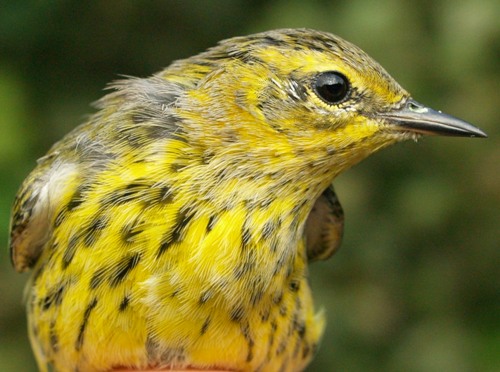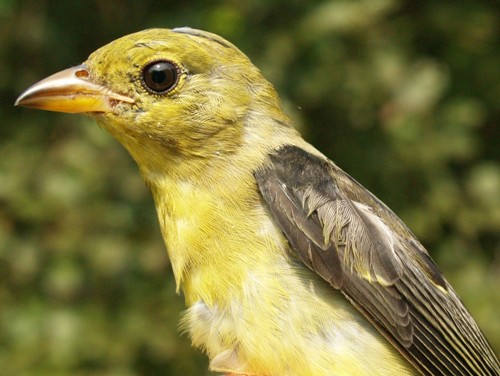|
Week 3: August 15-21, 2011 |
Welcome
to the McGill Bird Observatory weekly report.
Click here for a complete listing of our archives.
Comments or
questions are welcome at "mbo AT migrationresearch.org".
|
PICTURE
OF THE WEEK: |
|

A nice bright Cape May Warbler, only the 19th one banded at MBO.
(Photo by Simon Duval)
-
|
|
|
THIS WEEK |
THIS FALL |
2011 TOTAL |
SITE TOTAL |
|
# birds (and species) banded |
136 (33) |
532 (45) |
1620 (71) |
33189 (108) |
|
# birds (and species) repeat |
35 (16) |
129 (26) |
284 (36) |
5791 (68) |
|
# birds (and species) return |
3 (3) |
9 (5) |
104 (20) |
911 (37) |
|
# species observed |
78 |
88 |
141 |
202 |
|
# net hours |
480.0 |
1597.5 |
4434.5 |
54051.6 |
|
# birds banded / 100 net hours |
28.3 |
33.3 |
36.5 |
61.4 |
|
|
Note: table does not include nocturnal banding (owls) |
|
Bander-in-charge: Simon Duval, Gay Gruner
Assistants: Christine Barrie, Sue Bishop, Rui de Jesus, Jean Demers, Andrée-Anne Deschamps, Liette Fortier, Barbara Frei, Alison Hackney, Lima Kayello, Lisa Keelty, Tony James Kouach, Le Duing Lang, Francine Marcoux, Mevin Mongey, Chris Murphy, Cat Spina, Benoit Piquette, Ahmad Shah, Clémence Soulard, Bonnie Soutar, Rodger Titman, Monique Venne, Matthew von Bornhoft
Notes: Last week's report ended with us wondering whether week 3 would be more like the record high numbers of week 1 or the record low of week 2. Unfortunately, the lull in migration continued, with the 136 birds banded this week the second lowest for this period (only in 2007 did we band fewer birds in week 3). We also finally ran out of luck with weather at the end of this week, with Sunday rained out.

Over seven years, we have banded only 17 Scarlet Tanagers at MBO, all of them in fall, and in two of the last three years we've only banded one, so this individual was a particularly welcome highlight in an otherwise rather quiet week.
(Photo by
Simon Duval) |
Although the 78 species observed this week is well within the range of 72 to 84 observed during week 3 over the past five years, the cumulative total of 88 species is the lowest ever at this point in the season, with the count ranging from 92 to 99 in previous years. Hopefully many of the species missed to date will show up at MBO soon. The six new species observed this week were American Bittern, Belted Kingfisher, Yellow-bellied Sapsucker, Olive-sided Flycatcher, Yellow-rumped Warbler, and Scarlet Tanager; the bittern was actually our first for all of 2011. With the arrival of the first Yellow-rumped Warbler, we can't help but wonder whether this fall will bring a repeat performance of the spectacular numbers we observed from late September to mid-October last year, or instead a more traditional "odd year" drop in numbers (since 2005 we have documented a dramatic two-year pattern to Yellow-rumped Warbler numbers, with an average of 110 banded over three "odd" years, and an average of 1538 banded over three "even" years). As for birds banded this week, Scarlet Tanager was new for the year, while Great Crested Flycatcher and American Goldfinch were our first for fall. Also of note, a young coyote was seen along the census trail on Saturday; although we hear them most years (especially during our owling later in fall), we have only rarely seen them on site.
This week’s top 10 [last week's rank in brackets]
# individuals banded |
mean # individuals observed daily |
1. American Redstart (25) [1] |
1. Cedar Waxwing (29) [2] |
2. Song Sparrow (22) [2] |
2. Black-capped Chickadee (28) [3] |
3. Common Yellowthroat (10) [4] |
3. Song Sparrow (17) [6] |
4. Traill's Flycatcher (7) [8] |
4. American Crow (17) [4] |
5. Cedar Waxwing (6) [5] |
5. American Robin (13) [5] |
5. Ovenbird (6) [6] |
6. American Goldfinch (12) [7] |
7. Yellow-bellied Flycatcher (5) [-] |
7. American Redstart (11) [-] |
7. Tennessee Warbler (5) [6] |
8. Common Yellowthroat (10) [10] |
7. Yellow Warbler (5) [3] |
9. Red-eyed Vireo (6) [-] |
10. Black-capped Chickadee (4) [10]
10. Nashville Warbler (4) [-]
10. Black-and-white Warbler (4) [-]
10. Magnolia Warbler (4) [6] |
10. Ruby-throated Hummingbird (6) [-] |
|
American Redstart took top spot among birds banded for a second straight week, and that came as no surprise as it has also been number one in week 3 every year since 2007, except when pushed into second place by an unusually high number of Song Sparrows in 2009. Meanwhile Song Sparrow was the runner-up for a second week in a row, also as expected for this time of year. Common Yellowthroat moved up one position from last week, while Yellow Warbler tumbled to seventh place, showing that the big push observed during week 1 doesn't seem to be carrying on to the extent that we expected it might. Traill's Flycatcher had an unusually strong showing for week 3, by which time it is usually already tapering off in numbers, and similarly this was one of our best weekly totals ever for Yellow-bellied Flycatcher. Although Cedar Waxwing is a common species at MBO, it has traditionally been relatively scarce in the second half of August, and this is actually the first time it has ever made the top ten for week 3 - and topping the list of species observed is all the more surprising. Small numbers of Black-capped Chickadees, presumably local offspring, continue to be banded each week; otherwise the remaining species in the bottom half of the top ten comprised several more warblers, most of which we expect will soon increase in numbers.
As already noted, we were surprised to see the mean daily count of Cedar Waxwings top all other species this week. They only barely edged out Black-capped Chickadee, which is traditionally a dominant species at this time of year, in the top three every year except 2006. Song Sparrow moved up to third place this week, followed by a solid block of "Americans" - American Crow and American Robin maintained their rank from last week, while American Goldfinch edged up by one spot, and American Redstart jumped in at seventh place. Common Yellowthroat also increased a bit compared to last week, while Red-eyed Vireo and Ruby-throated Hummingbird numbers grew enough to make rare appearances in the top ten. Last week's top species, Red-winged Blackbird, dropped off the list entirely this week, going from a daily mean count of 31 to a total count this week of just 15 individuals. Although a drastic change, this is what we usually observe in week 1 or 2, so it appears that they were in fact just a bit late this year. The other species dropping out of the top ten since last week were Yellow Warbler and Common Grackle.
After a record busy first week followed by two unusually slow ones, we are now wondering whether the first week was a fluke, or the big numbers will resume once a good cold front moves through. Week 4 should give us a better idea which of these scenarios is closer to the truth...
|

A young House Wren, still with a visibly broad juvenile gape.
(Photo by
Simon Duval)
|



